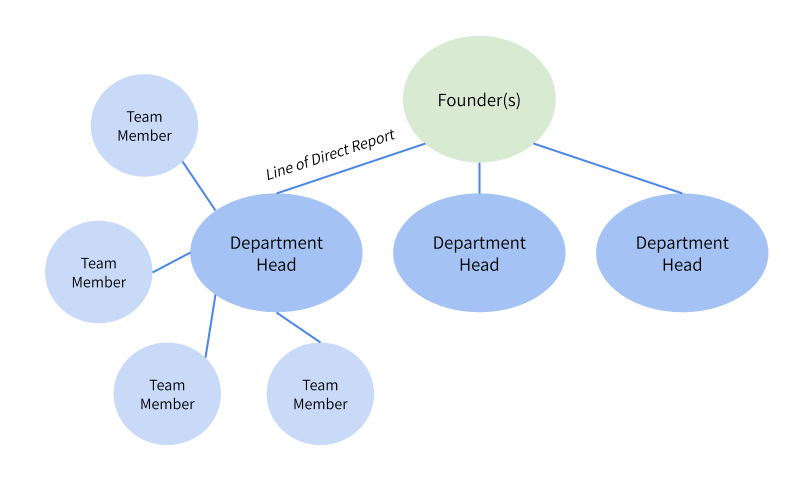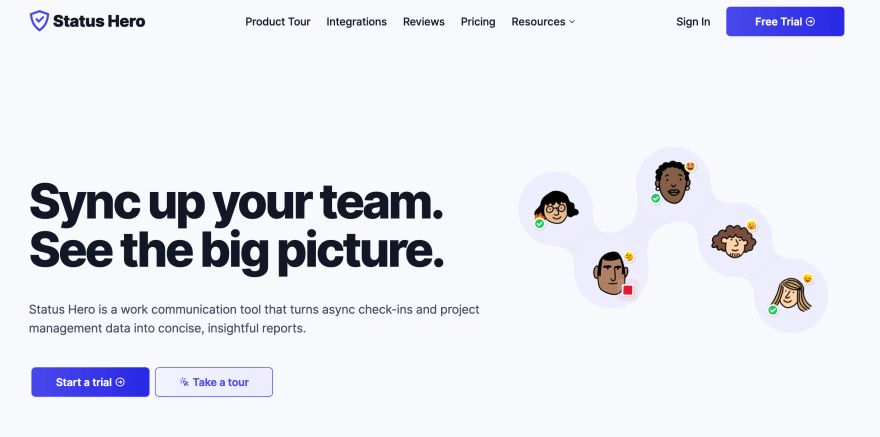===
I remember the first time I was put in charge of a team at a startup. I had been in leadership roles in college, but that was nothing compared to managing software engineers who were 5 to 15 years more experienced than myself.
It was scary and it stretched my comfort zone, but ultimately, learning to manage direct reports effectively was one of the most valuable skills I picked up early in my career.
What are Direct Reports?
Direct reports refer to employees that report directly to someone above them in an organization’s hierarchy. This person can be a team leader, supervisor, or manager.
In a startup, most organizational structures are simple, and might just consist of a founder with a few division heads or managers each responsible for a few direct reports.
As a startup manager or team lead, you are responsible for assigning work to direct reports, monitoring their performance, reviewing deliverables, providing feedback, and offering support whenever necessary. It’s your job to give your team direction and keep them motivated to meet deadlines and exceed expectations.
The hardest part of making the transition from team member to manager for me was changing the nature of my relationship with my peers. I was no longer on equal ground with them, but it’s not like I felt comfortable with having authority over them either.
Far too often, new startup managers struggle with this transition from peer to superior. Many have to deal with high expectations from the get-go and receive little to no formal leadership training. On top of that, management teams at startups tend to work longer hours, which can quickly lead to stress and burnout.
In this guide, I want to share some of the most common challenges I faced as a new startup manager. I’ll pass along a few tips that I hope will help you become a more effective leader to your direct reports as well.
Interested in learning more about management? Here are my favorite books for managers so you can fill up your reading list.
How to Manage Direct Reports
Effective leadership is important because it improves your team’s productivity and morale. It goes without saying that every workplace needs to invest in educating its leaders on the qualities and practices of effective leadership. However, this is rarely a reality, especially for startups with limited resources.
I’ve been managing teams for a few years now, and there are a few things I always aim to do as I hire, onboard, and adjust to my new direct reports:
1. Get to Know Your Team
Establishing open and honest communication in your team can lead to many advantages, such as an increase in productivity, job satisfaction, and teamwork.
If you’re new to the company, schedule one-on-one meetings with your direct reports. You can get to know them better and build rapport. Even if you’ve worked with your peers before, one-on-one sessions are very useful because they will reinforce your relationships with fellow team members. You can understand their expectations from you as their new leader. You can also figure out which communication styles fit your direct reports.
Ask inquisitive questions that can help you gauge employee experience. Prompt them to share what motivates them at work, what they’ve been struggling with lately, what they’ve learned recently, how they feel about the company and its direction, or how they’ve been generally doing.
Facilitating open conversations can let the team know that you care and that you’re listening. However, don’t overdo it. Avoid offering advice unless they ask you to, especially when it comes to personal problems that might be affecting their performance.
Be consistent with these one-on-one meetings. No matter how brief, you should carve out time in your schedule to talk to each direct report. This would let your team know that they are valued and appreciated.
2. Give Feedback
Giving your team constructive criticism can help them improve their overall performance and minimize errors in the future.
Aside from holding one-on-one meetings to get to know your team better, you can use these sessions to evaluate their performance and provide feedback. I like doing structured feedback sessions every quarter using a rubric to gauge each employee’s performance.
By doing regular performance evaluations, you can identify knowledge and skills gaps in your team. If, say, multiple new hires are struggling to finish projects on time, there might be a problem with the systems or expectations you have in place. You can respond quickly by providing additional resources and training to fill in those gaps.
3. Focus on Your Team’s Growth
Professional development is often overlooked, but it is a very crucial component of every successful business. As a manager, you should play an active part in your team’s professional development. Ask them: *What are your long-term goals? Do you feel like you’re making progress on your goals here? *
The more rapport you have with your team, the more likely they will be to share their goals with you. Many of the employees you talk to not be able to answer simply because they’ve yet to be asked about these things. In such cases, don’t force them to answer. Give them time to reflect. Instead, revisit the discussion in future one-on-one meetings.
Talking to your direct reports enables you to get a better understanding of their personal and professional goals. You can create a development plan around these goals and provide proper guidance. In doing so, you can nurture the future leaders of your company.
Take note that a development plan has to be customized to fit the abilities, interests, and goals of each employee. Thus, no two development plans are the same.
An effective development plan can help your team gain the knowledge and skills they’d need to propel their careers. That means you should invest in opportunities for growth. These may come in the form of special projects, one-on-one coaching, conferences, or network events. Then, you need to create opportunities within your organization where they can apply their new skills.
By focusing on your team’s growth, you can retain top talent, which would save a lot of time, energy, and money on recruitment, onboarding, and training.
The cost of losing an employee is high. One study found that replacing a highly skilled worker costs an employer about 213% of their annual salary. However, Global Industry Analyst Josh Bersin posits that the true cost of turnover ranges from tens of thousands of dollars to two times the annual salary of the worker.
4. Empower Your Team
The biggest mistake new, insecure managers make is micromanaging instead of empowering their team. Your best employees will thrive when given more autonomy.
As a leader, you must demonstrate trust to drive productivity. Allow your team to make their own decisions and take responsibility for the outcomes. This can boost the creativity, motivation, and performance levels of your team. It can also improve employee experience, which can lead to lower absence rates and turnover rates.
Autonomy in the workplace means giving your team the flexibility and options to achieve their performance goals in their own way. Instead of laying out the directions for reaching their targets, give them a supportive nudge. For instance, you can delegate projects and give your team authority over them.
Increasing autonomy doesn’t mean abandoning your team.
You shouldn’t leave them to solve problems all by themselves. You still have to provide guidance. Ask them questions that can prompt your team to devise their own solutions. It’s your job to help them define and dissect the problem so they can come up with appropriate solutions.
Apart from encouraging more autonomy, you can empower your teams by nurturing an open, judgment-free workplace, where your employees can freely share their opinions and ideas. Recognizing risks and rewarding accomplishments can empower your teams, too. In workplaces where employees feel valued and respected, motivation is usually high.
5. Use Technology When You Can
There are all kinds of tools on the market that can help you manage direct reports. In general, these tools give you access to everyone and everything you need, including your work and your apps, from a single platform. It simplifies and streamlines operations for you, allowing you to give updates, feedback, and recognition from the same tool.
Having the right tools improves your effectiveness as a manager. You can delegate tasks, run meetings, and measure performance levels more effectively with reliable tools at your disposal. You can also automate mundane and repetitive tasks, so you can focus on value-added activities.
My Management “Stack”
I have used a lot of different tools for managing my direct reports over the years. Many are right for some teams and wrong for others - for example, I no longer use Slack, but other businesses depend on it.
Take a look at these tools and use them as a jumping-off point for building your management tool stack.
Trello
As one of my go-to project management tools, Trello is simple, powerful, and relatively easy for new teams to pick up. I use a standard format with columns for:
- Backlog - Projects that haven’t been fully planned. This is a good place to keep ideas.
- Planning - Projects that are being fleshed out. Usually we’re still learning about the issue or coming up with possible solutions.
- Ready - Cards in “Ready” are prioritized and fair game for any relevant team members to start on.
- In Progress - When team members are actively working on a project, they move it to “In Progress.”
- Done - After they’re done, the card is moved to “Done” where we archive old cards after a few weeks.
- Recurring - Some tasks come back every month or week, so for this we use Trello’s card repeater and bring them back every week or month.
At $10 per team member, Trello provides incredible value, especially as they’ve added more integrations and automations over the years.
Airtable
I use Airtable for hiring, storing professional contacts, and much more. It’s a very versatile tool, and like Trello it integrates with most other tools via Zapier or direct API access.
Google Suite
Google Docs, Sheets, and Slides have basically caught up to Microsoft Office now, plus they’re basically free. The sharing and collaboration settings are intuitive, and they can also be integrated with many other management tools I like.
Status Hero
Status Hero is an online communication tool designed to replace lengthy meetings with concise interruption-free reports. It’s ideal for remote or hybrid setups with a distributed workforce as it increases transparency and simplifies processes.
15Five
15Five is a performance management tool that enables you to support your team’s growth through real-time feedback, recognition, weekly check-ins, and one-on-ones. Apart from its suite of products, 15Five has resources and courses to improve your effectiveness as manager.
Briskine
I just recently started using Briskine to help my team share common email templates. I’ve only recently started managing marketing and account management teams, so having a shared directory of email templates has been really helpful.
Recommended Reading
You have to keep learning if you want to be an effective manager. In a fast-changing world, continuous learning can help you keep up with the latest technologies, practices, and industry standards, so you can equip your team with the skills and knowledge to thrive.
There are several management books I like that helped me on my journey as a leader. Here are a few of my favorites.
Business Adventure by John Brooks
Bill Gates and Warren Buffet speak highly of this book. Detailing a series of business events that occurred between the 50s and the 60s, it doesn’t give solutions or instructions but offers valuable business insights. Although the particulars of business have changed over time, the fundamentals remain the same, which is why this book is still relevant to this day.
True North: Discover Your Authentic Leadership by Bill George
Derived from 125 interviews of the top business leaders, True North offers a solid process for leadership success. It shows you how to make your own Personal Leadership Development Plan using five simple steps.
The Decision Maker by Dennis Bakke
The Decision Maker explains the importance of giving employees the freedom and responsibility to make important decisions through a fictional management story. Bakke shows how simply making employees responsible for more decision-making autonomy can transform an entire organization.













Top comments (0)